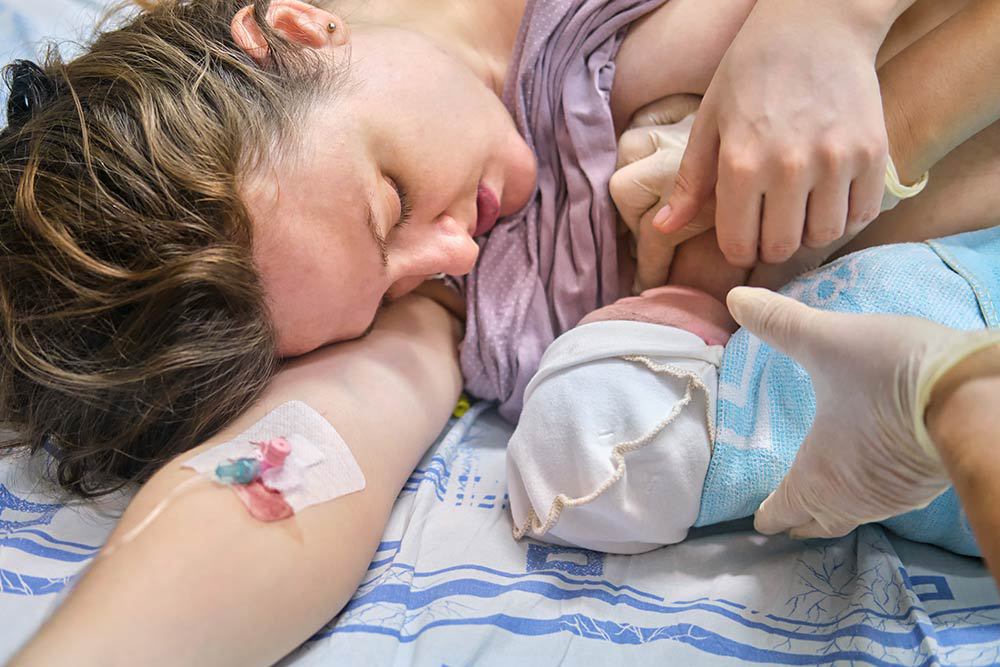What To Expect In the 24 Hours After Vaginal Delivery

Because birth is just the beginning.
You’ve read the pregnancy books. You can rattle off what size fruit your growing baby is at any given time. Your birth plan is printed, hospital bag packed. And while every day for nine months you’ve imagined what bringing a baby into your world will be like, you probably haven’t thought much about the hospital experience after the new baby is born. Most of the literature focuses on getting the baby earthside, then welcoming them into your home, but as for the postpartum period in the days after a vaginal birth before going home? Radio silence.
When I had my son last year, I found myself wondering why there was no book called “What to Expect in the 24 Hours After Childbirth When You Feel Like You Got Hit by a Truck, Hungry, and Kinda Terrified but Deliriously Happy.”
Well it may not be book-length (you have enough to do), but this is something I wish I’d stumbled upon before giving birth: we’ll dive into what to expect in the 24 hours after vaginal delivery with expert insight from Angela Genzale, BSN, RNC-0B, a nurse and certified life coach in Issaquah, Washington, and Victoria Scott, MD, a urogynecologist in Los Angeles and the co-author of A Woman’s Guide to Her Pelvic Floor: What the F*@# is Going On Down There.
Delivering the Placenta
While many books touch on this briefly, it’s not widely known among those who haven’t given birth that labor isn’t actually over once the baby comes out. You still have to deliver a whole other organ, the placenta. Fortunately, the placenta is gelatinous and doesn’t have shoulders, so hopefully, this isn’t a major deal, especially compared to the birth itself.
“The placenta should detach from the uterine wall, usually within 20 minutes of delivery. Sometimes, it is assisted by fundal massage (rubbing the top of the uterus). Sometimes pitocin is given to help the process,” Genzale says. “Because it is much smaller and squishier than the baby, delivering it usually [is] not a big deal.”
She adds that ideally, the placenta is delivered intact, and no additional interventions are needed. In rare cases, all or some of the placenta remains attached, known as a retained placenta. Left untreated, it can cause pain, cramping, severe bleeding, and fever. Usually, medication or a dilation and curettage (D&C) procedure is needed to get the remaining placenta out, but your health care provider and medical team will guide you in this very uncommon scenario.
Peeing for The First Time After Birth
Peeing for the first time after birth is often daunting, but after the catheter is removed (if you had an epidural), it’s essential to keep your bladder empty as this will reduce uterine pain (a full bladder puts pressure on the uterus, which can make those afterpains worse).
Your nurse will help you get to the bathroom; even if you feel OK, it’s important to allow them to help you. “Your legs may be weak from the epidural or the exercise of labor. You may feel lightheaded or pass out due to blood loss, fluid shifts, or exhaustion,” Genzale says, adding that if the bladder gets overstretched, it can cause problems with being able to urinate in the future.
Epidurals can also numb the motor and sensory nerves, including those in the bladder. “It can be hard to urinate even when the numbness in the legs has worn off. I don’t think people expect that part,” Genzale says.
Will peeing burn? Sorry to be the bearer of bad news, but yes, probably.
“Often, there can be small tears or abrasions near the urethra during birth, and of course other tears in the vagina and perineum,” Genzale says. “Urine is like pouring an acidic solution over an open wound.” Yikes. There also may be swelling that can make it hard to pee.
There are tricks to help you urinate, though, so don’t panic (and, truly, it’s really not that bad for most). The nurses will spray a peri bottle full of warm water onto the vagina and perineum, diluting the urine so it doesn’t sting as badly (you can do this at home too). I was a big fan of the Dermoplast numbing spray the hospital provided. And if you’re having trouble peeing, Genzale says putting a drop of peppermint oil in the urine hat (the bowl that goes over the toilet to collect urine) can help people pee (studies support this, too). Another trick? Blowing bubbles through a straw into a cup of water relaxes the sphincter and allows the body to let go.
Breastfeeding
I don’t know what I expected, but I was so surprised by how, soon after birth, my son was wiggling toward my breast, guided by instinct and ready to eat.
“Many full-term babies will be ready to latch onto your nipple and start breastfeeding within the first two hours after delivery,” Dr. Scott says. If possible, the American Academy of Pediatrics (AAP) recommends skin-to-skin contact with the baby and mother for the first hour after birth. “This is a good time to see if your baby will latch,” notes Dr. Scott, adding that it’s helpful to have read about breastfeeding ahead of time or even taken a class so you have an idea of how to nurse, “but you will also likely be exhausted and possibly delirious after the delivery, so don’t hesitate to ask any of the nurses in Labor and Delivery for help.”
Genzale adds that skin-to-skin is now standard practice after a C-section, too. “Skin-to-skin has been a game changer in my practice, and honestly, babies feed so much better when this occurs,” she says.
“For full-term, uncomplicated deliveries, most babies are alert for the first 1 to 2 hours and will feed well the first time. It is important to remember that babies prioritize breathing first, and some will need to get rid of fluid in their system before they are ready to eat. If [breastfeeding still] doesn’t work, we would assess what factors contribute to that and adjust from there,” she says.
But babies don’t need much in terms of breastmilk right out of the gate. “They have plenty of reserves, so it’s not crucial for them to feed right away, but it is important to stimulate the breasts,” Genzale says. “If they aren’t interested in feeding, I usually have the mom do some breast hand-expression. The stimulation signals to her body to make milk. If colostrum comes out, we put it in the baby’s mouth.”
Your medical team and lactation consultant will help you figure out how to breastfeed (be prepared to be bare-chested in front of a whole slew of strangers—but don’t worry; it’ll be the least of your concerns after birth). In Oregon, where I live, every person sees a lactation consultant in the hospital and once after going home, and this was really helpful for me.
Your Epidural Wears Off
You may find that you’re anxious for your epidural to wear off so you can move around a bit more freely, but you may also be unsure of what to expect when that happens.
“An epidural can take up to four hours to wear off,” Dr. Scott says. “Remember, a small human just came out of your body, so you will feel pain once you regain sensation.”
I, for one, felt like I had done the most intense workout of my life, which I guess I had. You will likely feel sore all over, especially in the muscles required for pushing, like the abs, legs, and back.
“Not only will you be recovering from stretching of the vagina and pelvic floor or an incision in your lower abdomen, but the uterus will also be contracting to decrease back to its normal size,” explains Dr. Scott. “This can cause crampy, contraction-like pain. If you did not have an epidural for delivery, you may also start to feel more pain after the delivery when your endorphin levels start to decrease,” she adds. You may also feel pain in your back or spine where the epidural went in.
Fundal Massages
There’s nothing fun about fundal massages (sorry, I’ll stop). This is when the nurses push on the uterus after birth to help it contract back to its normal size, which helps stop postpartum bleeding.
“Fundal massage is one of the worst jobs for postpartum nurses,” Genzale says. “Yes, often it hurts.”
After birth, the uterus needs to contract to close off the open blood vessels left where the placenta detaches. “If the uterus is not contracted and the patient is bleeding more than normal, fundal massage is the way to get the uterus to contract and minimize heavy vaginal bleeding (along with Pitocin or other medications if necessary).” She adds that keeping the bladder empty can help minimize pain, and one of the benefits of breastfeeding in those early hours after birth is that it releases oxytocin (Pitocin is just synthetic oxytocin), which helps contract the uterus.
What To Expect the First Night
If your baby is doing well, they will likely sleep in a bassinet in your room with you, though some hospitals allow the baby to sleep in the nursery. “Ask the nurses for help swaddling the baby to keep her warm and comfortable,” suggests Dr. Scott. “If you are having difficulty with breastfeeding, don’t hesitate to ask for help from the nurses and a lactation consultant.”
It will be hard to sleep through the night because health care staff will be coming in frequently for various postpartum checkups and monitoring, plus the baby will need to eat, and your body will still hurt. You’ll also be experiencing intense hormone shifts, which can cause mood changes, so don’t be surprised if you’re laughing one minute and sobbing the next. Night sweats can also make it hard to sleep (pro tip: pack more soft shirts than you think you’ll need so you have something dry to change into).
“Patients are often surprised at the frequency of vital signs and fundal checks, getting up to the bathroom, and breastfeeding. If you get a stretch of 2 or 3 hours of sleep, that is good,” Genzale says. “There’s a lot to accomplish in a short time since most vaginal deliveries spend only 24-32 hours in the hospital.” She tells patients to bring a sound machine or earplugs (you’ll still hear the baby cry), a sleep mask, your own pillow—whatever will help you rest as much as possible. Gezaele noticed during COVID-19 that patients and new moms seemed to do better when visitors were not allowed in the hospital. “I think having extra rest and uninterrupted bonding time was helpful in many ways,” she says. Remember, any visitor should be there to help you rest; if not, they can wait.
Going Home
PSA: You don’t need to poop in order to be discharged to go home (and you can ask for a stool softener if you’re freaked out about constipation or you suffered hemorrhoids). Typically if all is well with mom and baby, you can expect to be discharged within 24 to 48 hours after a vaginal delivery. You may be antsy to get home, but you want to ensure you’re ready. “Whether you have had a vaginal delivery or C-section, your doctor will ensure you are safe to go home before discharge,” Dr. Scott says.
Usually, this means that you’ll be able to eat solid food without nausea or vomiting, your pain is controlled, you can walk unassisted, you’ve peed, and your heart rate, temperature, and blood pressure have all been normal. “They will also make sure your vaginal bleeding has slowed down, and the uterus is starting to contract and shrink in size,” Dr. Scott adds.
It’s normal to have bleeding for days or even up to six weeks after birth. The bleeding, known as lochia, is actually a vaginal discharge made up of blood, mucus, and uterine tissue, and don’t be alarmed by its distinctly musty smell. Take the sanitary pads, ice packs, mesh underwear, and the witch hazel pads from the hospital room—they won’t be able to use them again anyway.
Here’s the thing: just as nothing can truly prepare you for parenthood besides doing it, nothing will make you feel 100% ready for birth and its aftermath, especially if it’s your first time. But when you’re daydreaming about birth and baby, think about those days you’ll spend in the hospital before you go home. Having a (loose) after-birth plan that considers things like where you want the baby to sleep, what your visitor “policy” is, and whether or not you’re open to pain medication can help you prepare for those loopy and hopefully wonderful first 24 hours with your baby.







